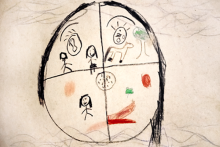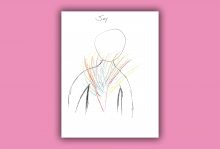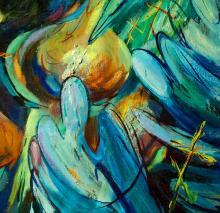drawing

WHEN I WAS 7 or 8, I drew a picture of God in Sunday school. I may have been given a coloring sheet, but I knew I needed a blank sheet of paper that morning. Thankfully, I was in a church that trusted and listened to children and provided me access to crayons and paper. They didn’t stifle my creative impulse. I started with a big circle and confidently mapped out a visage that was male and female, happy and sad, and reflecting all of creation. I shared it with my class and my teacher asked me to share my picture during worship, a gathering of about 40 people on folding chairs. Even as a young child, I felt like a valued member of New Community Church, one of a handful of small churches affiliated with the Church of the Saviour in Washington, D.C. It did not feel strange when my pastor encouraged me to talk about my picture in church or when the adults listened. Later, a church member and poet, Cheryl K. Hellner, interviewed me for Potter’s House Press, a small “journal of faith and the arts.” This is how I described my drawing:
I was going to draw another part right there / to make it sometimes happy and sometimes frowning / It’s divided up into four halves / On this whole half is the woman’s part / and this half — it’s the man’s / And this eye is the world, and this eye is space / This eye is really the planets / And then the nose is space / And this part is nature / And this part is people / And all of it is God.

IT'S LONG BEEN known that empathy may be inherent in portraiture—walking a mile in the shoes of one’s painting subject. As the renowned 15th-century painter and monk Fra Angelico put it, “He who wishes to paint Christ’s story must live with Christ.” New research reinforces this association between artmaking and spirituality.
A 2020 Fetzer Institute study of U.S. spirituality, which includes 16 focus groups and 26 in-depth interviews, reports that more than 80 percent of its 3,600 respondents self-identified as somewhat spiritual, and about 60 percent aspired to be more spiritual. Novelly, researchers used drawings as an “inductive research tool” to understand better what respondents meant by “spirituality,” said Veronica Selzler, lead author of the Fetzer study and strategy director at Hattaway Communications in Washington, D.C. Art allowed participants to define spirituality creatively rather than prescriptively. “It was through these drawings that the diversity and common threads began to emerge,” she said.
The study reproduced 38 drawings in which respondents, aged 18 to 71, interpreted spirituality. The “slightly spiritual/not religious at all” Dale, 69, drew five clouds—one perhaps smiling—and grass as his “happy place, but you could call it a spiritual place.” Daniel, 20, who is “very spiritual/not at all religious,” drew a self-portrait praying on his knees before Jesus.

On the second Sunday of Lent, John Hendrix sits in one of the pews near the back of Grace and Peace Fellowship, a Presbyterian church with stained glass in green and orange, and a giant, organ pipe front and center.
Casually decked in a striped, button-down shirt and jeans, he looks like any other member of the hip and young crowd. With his wife, Andrea, and his two children, Jack, 8, and Annie, 5, Hendrix stands and sings and partakes of gluten-free communion.
But as soon as the sermon starts, Hendrix sets himself apart, whipping out his sketchbook and pens to draw the pastor’s sermon.